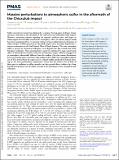Files in this item
Massive perturbations to atmospheric sulfur in the aftermath of the Chicxulub impact
Item metadata
| dc.contributor.author | Junium, Christopher | |
| dc.contributor.author | Zerkle, Aubrey Lea | |
| dc.contributor.author | Witts, James | |
| dc.contributor.author | Ivany, Linda | |
| dc.contributor.author | Yancey, Thomas | |
| dc.contributor.author | Liu, Chengjie | |
| dc.contributor.author | Claire, Mark | |
| dc.date.accessioned | 2022-03-24T09:40:51Z | |
| dc.date.available | 2022-03-24T09:40:51Z | |
| dc.date.issued | 2022-04-05 | |
| dc.identifier | 277631202 | |
| dc.identifier | 92c7d7c2-b240-4f90-9e64-d0caf0b2e099 | |
| dc.identifier | 85126844757 | |
| dc.identifier | 000789363900019 | |
| dc.identifier.citation | Junium , C , Zerkle , A L , Witts , J , Ivany , L , Yancey , T , Liu , C & Claire , M 2022 , ' Massive perturbations to atmospheric sulfur in the aftermath of the Chicxulub impact ' , Proceedings of the National Academy of Sciences of the United States of America , vol. 119 , no. 14 , e2119194119 . https://doi.org/10.1073/pnas.2119194119 | en |
| dc.identifier.issn | 1091-6490 | |
| dc.identifier.other | ORCID: /0000-0003-2324-1619/work/110423280 | |
| dc.identifier.other | ORCID: /0000-0001-9518-089X/work/110423282 | |
| dc.identifier.uri | https://hdl.handle.net/10023/25079 | |
| dc.description | This project has received funding from the National Science foundation (EAR 1455258 to C.K.J), the European Research Council under the European Union’s Horizon 2020 research and innovation programme (Grant 678812 to M.W.C.) and a University of St Andrews Global Fellowship (to C.K.J.). | en |
| dc.description.abstract | Sulfate aerosols have long been implicated as a primary forcing agent of climate change and mass extinction in the aftermath of the end-Cretaceous Chicxulub bolide impact. However, uncertainty remains regarding the quantity, residence time, and degree to which impact-derived sulfur transited the stratosphere, where its climatic impact would have been maximized. Here, we present evidence of mass-independent fractionation of sulfur isotopes (S-MIF) preserved in Chicxulub impact ejecta materials deposited in a marine environment in the Gulf Coastal Plain of North America. The mass anomalous sulfur is present in Cretaceous–Paleogene event deposits but also extends into Early Paleogene sediments. These measurements cannot be explained by mass conservation effects or thermochemical sulfate reduction and therefore require sulfur-bearing gases in an atmosphere substantially different from the modern. Our data cannot discriminate between potential source reaction(s) that produced the S-MIF, but stratospheric photolysis of SO2 derived from the target rock or carbonyl sulfide produced by biomass burning are the most parsimonious explanations. Given that the ultimate fate of both of these gases is oxidation to sulfate aerosols, our data provide direct evidence for a long hypothesized primary role for sulfate aerosols in the postimpact winter and global mass extinction. | |
| dc.format.extent | 871222 | |
| dc.language.iso | eng | |
| dc.relation.ispartof | Proceedings of the National Academy of Sciences of the United States of America | en |
| dc.subject | K-Pg extinction | en |
| dc.subject | Sulfur isotopes | en |
| dc.subject | Mass-independent fractionation | en |
| dc.subject | Mass extinction | en |
| dc.subject | Sulfur cycle | en |
| dc.subject | GE Environmental Sciences | en |
| dc.subject | DAS | en |
| dc.subject | SDG 13 - Climate Action | en |
| dc.subject | SDG 14 - Life Below Water | en |
| dc.subject.lcc | GE | en |
| dc.title | Massive perturbations to atmospheric sulfur in the aftermath of the Chicxulub impact | en |
| dc.type | Journal article | en |
| dc.contributor.sponsor | European Research Council | en |
| dc.contributor.institution | University of St Andrews. St Andrews Centre for Exoplanet Science | en |
| dc.contributor.institution | University of St Andrews. School of Earth & Environmental Sciences | en |
| dc.contributor.institution | University of St Andrews. St Andrews Isotope Geochemistry | en |
| dc.identifier.doi | https://doi.org/10.1073/pnas.2119194119 | |
| dc.description.status | Peer reviewed | en |
| dc.identifier.grantnumber | 678812 | en |
This item appears in the following Collection(s)
Items in the St Andrews Research Repository are protected by copyright, with all rights reserved, unless otherwise indicated.

